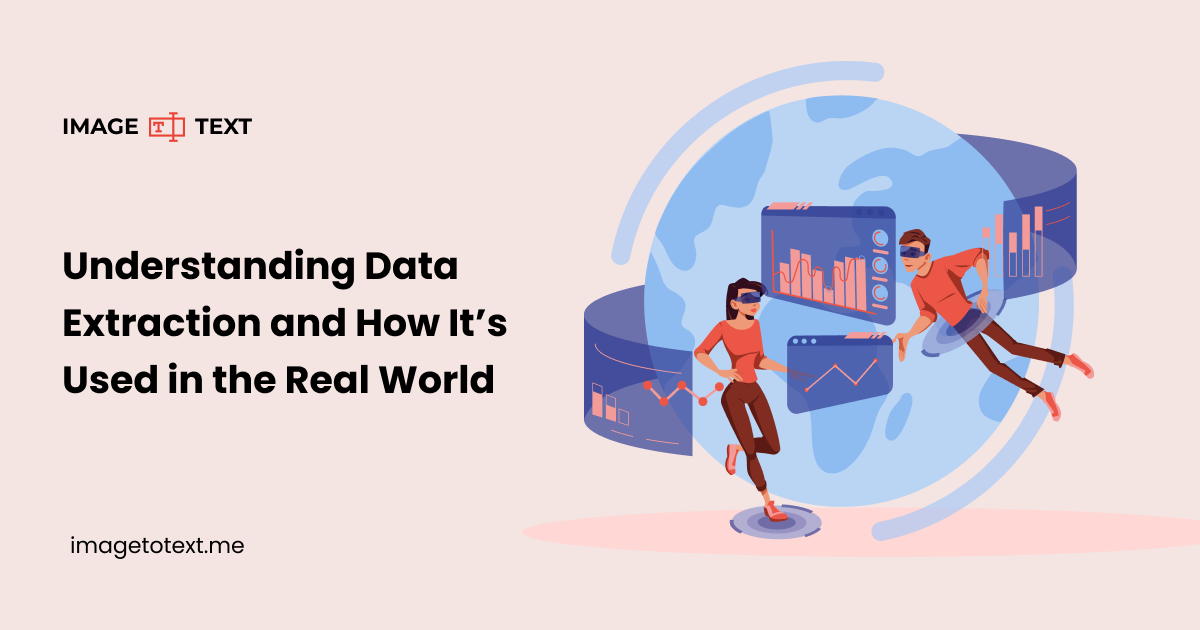Understanding Data Extraction and How It’s Used in the Real World

Data is paramount in the modern business climate. Having the right data enables businesses to make the right decisions that lead to better services, products, and, of course, profits.
Nowadays, massive databases are maintained by most enterprises. These databases are updated with new data on a daily basis. However, having data and being able to use it are not the same. This is where data extraction comes in.
Let’s check out what data extraction is, how it works, and how it is used in real life.
What is Data Extraction?
Data extraction refers to obtaining structured or unstructured data from various sources such as databases, documents, websites, surveys, etc, and converting them into a usable format. Once the data is converted, it is used for analysis, reporting, or simply stored for later use.
Common sources of data extraction are:
- PDFs
- Scanned Forms
- Digital Forms
- Emails
- APIs
- Databases
- Websites
And more. Once extracted, the data is usually stored in CSV, JSON, or XML format. Or it is placed in a data warehouse.
Types of Data Extraction
Data extraction can be done in a few different ways. There are manual methods and automated methods, and there is a mix of both. Let’s see what each method entails.
- Manual Extraction. Manual extraction of data is the process of retrieving data from sources using human intervention. A person has to vet, extract, and process the data all by themself. The process is slow, but usually more accurate than automated extraction.
- Automated Extraction. In automated extraction, software automatically extracts data from a source without human intervention. It is much faster, but it's not very accurate.
- Manual Intervention in Automated Extraction. In this method, most of the data extraction is automated; however, humans still intervene during crucial stages to ensure that the data extraction is of high quality.
- AI Assisted Extraction. In this method, powerful machine learning algorithms are trained to perform data extraction that is fast and of nearly the same quality as manual extraction.
How Does Data Extraction Work
No matter what kind of method is used to extract data, the following processes always happen. They are the core components of a data extraction pipeline.
-
1. Determining Data Sources
To do data extraction, you have to have a source of data. It is understood that there can be many sources to pull data from, so first, you have to determine which sources you are going to use.
Are you going to be pulling data from digital sources? If yes, then you need to look out for website data, forms, and digital documents.
Are you going to be pulling data from non-digital sources? Then you need to create a pipeline for converting that data into a format that your data extraction process can use. This can include digitizing documents, extracting text from images, and whatnot.
2. Connecting the Data Source with the Extraction Pipeline
The next step is to establish a connection between your data sources and the data extraction software/solution. You will need to use different methods for different sources. For example, if you are literally using a database, then you will need to use data querying strings. If you are scraping content from the web, you will need an API hook.
3. Data Retrieval From Source
Once the sources are connected, you need to retrieve the data from them.
- For databases, you will need to create queries to obtain the data.
- For physical documents, images, and even websites, you will need OCR to get the data.
Modern data extraction software simplifies this step a lot. So, don’t worry about it too much.
4. Data Transforming and Loading
Finally, it's time to load the data and process it. However, before loading, the data needs to be transformed. The reason is that your data may be in a different format than what your processing software requires.
For example, your data may be in JSON format while the required format is CSV. So, a transformation step is required to deal with such issues. After that, the data is loaded, and the role of data extraction ends here.
The Role Of Data Extraction in Data Pipelines
In a data pipeline, data extraction is the first step. A data pipeline is a series of steps that move data from one system to another. The data is moved from a data source (like a database, API, or sensor) to a destination (like a data warehouse, analytics platform, or dashboard). Along the way, the data may be extracted, cleaned, transformed, and stored.
There are two major types of data pipelines. ELT and ETL.
(i). ELT (Extract, Load, Transform)
ELT stands for extract, load, and transform. It stands for the order in which the data is processed. As shown by the name, the first step is Extraction, then loading, and then transforming.
In this method, the data is transformed by the app/software that has to process it. All the data extraction tool has to do is get the data and pass it on.
(ii). ETL (Extract, Transform, Load)
ETL is the more commonly known method. In this one, the data is first extracted, then transformed, and then passed along to the final app/software.
This is also the preferred model of data extraction if further processing is necessary. Otherwise, if you are just storing the data, then the ELT method is fine too.
Where is Data Extraction Used in Real Life?
Nowadays, data extraction is used in a lot of places. You can see some of the applications discussed below.
Analytics and Reporting.
Modern businesses collect customer data and use it for analytics and reporting. They check how their customers are interacting with their products and platforms and use that data to improve them.
Operational Applications.
Modern businesses have to aggregate data from different sources to get the correct analysis. For example, a chain restaurant will aggregate data from different branches’ POS(point-of-sale system), online orders, and deliveries.
Legacy-to-cloud Migration.
Data extraction is heavily used when migrating from legacy systems to a modern, possibly cloud environment.
Government offices and Public Transport.
Government offices and public transport facilities often use data extraction to verify IDs and other relevant documentation. Things like tickets, a national identity card, or a driver’s license are physical. A system that can scan them to extract their information and verify it digitally is employed at such places to avoid fraud and scams.
Data extraction is not limited to these uses. However, these examples should serve you well in understanding where and how data extraction can be applied.
What Are Some Types Of Tools Used For Data Extraction?
There are many types of data extraction tools that you can use. You can check out some of them here.
Image To Text Converter.
An image to text converter is a tool that can extract text from images, PDFs, and other digital sources that have uneditable and uncopyable text. This also includes pictures of physical documents, signs, forms, etc.
With an image to text converter, the text data from these sources can be extracted, stored, and processed later.
HTML Source Code Viewer.
Online sources are also commonly used for data extraction. An HTML source code viewer is often employed in such cases to get the raw data from a webpage. RAW data is useful in data pipelines because it can be customized and cleaned to better suit the processing software.
Database Query Tools.
Digital databases are very secure. They have access limitations to prevent data theft. Users need to be well-versed in the relevant database query software to extract data from it. Popular examples include:
- DBeaver. A GUI data extractor for SQL databases.
- pgAdmin. Another SQL-focused query software.
- MongoDB Compass. A GUI explorer for MongoDB databases.
API Integration Platforms.
Many platforms, such as Zapier and Workato, provide APIs to integrate with apps like Google Analytics and Salesforce. They use the integration to extract data. They also provide other tools to process or analyze the data.
Some Best Practices for Data Extraction
Data extraction is a time-consuming and resource-heavy task. That’s why there are certain best practices that you must follow to limit the pressure on your data extraction pipeline.
- Extract Only The Required Data. Do not extract all of the data from a source. That can take a long time and delay your processing pipeline. Instead, identify your needs, and only take the data relevant to them. This way, you will save time and prevent resource overuse.
- Use Incremental Extraction. Incremental extraction refers to only extracting updated or new data from a database. This approach uses flags or timestamps to check for new/updated data and extracts it. The benefit is that you don’t have to reextract the whole database every time, thus saving time and resources.
- Schedule Automated Extractions. You shouldn’t extract data manually every time. If you know that some data has to be extracted routinely, then automate the process using scripts, cron jobs, or ETL tools. Make sure to schedule the extraction for off-peak hours so that resources are not taken away from more critical tasks.
- Validate Data Before and After Extraction. Validation is required to ensure that the data is both relevant and complete. Things to check out for may include: empty fields, schema changes, and that the number of rows and columns match expectations.
- Keep It Secure. Databases are one of the primary targets of modern hackers. So, they should be secure. Always use secure connections (like HTTPS or SSH) during extraction. Apply access controls so only authorized users or systems can access the source data. If you're dealing with sensitive data, consider masking or encrypting it during transit and storage.
Conclusion
Data extraction has become an indispensable process in the modern service industry. Without actionable data, companies cannot provide their services efficiently. That’s why learning how to do proper data extraction and using the data effectively is crucial for success.
Related Blogs

3 Easy Techniques for Extracting Text From Images
Learn about 3 easy techniques for extracting text from images.

